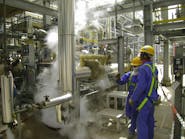Raman process monitoring — more options with fewer barriers
Raman spectroscopy is a common analytical technique that allows researchers and process manufacturers to analyze the chemical composition of solid, liquid or gaseous materials. It has become increasingly implemented in various applications — including biopharmaceutical manufacturing — but its analytical workflow is often complex, requiring the installation and use of highly specialized equipment, as well as expert knowledge in Raman spectroscopy techniques. This article discusses the growing versatility of this method, and outlines the need for modern process analytical technologies that are more accessible to lab technicians without compromising accuracy or reliability, irrespective of whether sampling is performed on-line, in-line, at-line or off-line.
Biopharmaceutical manufacturing processes can be extremely complex, as they depend on living organisms to generate products of interest. It is crucial that every aspect of the procedure — and the underlying reactions — is fully understood to ensure optimal process control. Even slight variations in the environment can have a tremendous impact on yield and quality, with costly knock-on effects that include failed batches, inefficient use of resources and end products that do not meet quality specifications. This is compounded by limited data to help drive improvements over time, putting patient safety and stakeholder interests at risk.
Process monitoring
Process production — or process manufacturing — refers to a method of combining supplies, ingredients or raw materials to produce goods according to a formula or recipe. Typically, it is used for bulk production of goods such as pharmaceuticals, foods and beverages, refined oil, gasoline, chemicals and plastics. Numerous checks are made throughout the process, from establishing the quality of the raw materials and intermediate compounds, all the way through to testing the purity of the end product. This requires process analytical technologies (PATs) that are reliable and accurate, and sufficiently adaptable to allow them to be employed at a variety of locations and interfaces. Raman spectroscopy is one such technology, and is increasingly being adopted for process production.
A clear insight
Raman spectroscopy is one of the most powerful and advantageous analytical technologies available for process monitoring, offering rapid, non-destructive, accurate and versatile sample analysis. Laser light is directed at the sample via a fiber-optic cable with a probe at its end. The energy from the laser causes covalently bonded molecules in the sample to vibrate and scatter the light. This can be either elastic scattering, with the energy of the molecule unchanged after interaction with the photon, or inelastic, where the molecule absorbs some of the energy and the scattered photon loses energy. The inelastically scattered light is collected and interpreted by a detector, generating a Raman spectrum that is unique to each molecule. This “molecular fingerprint” enables both qualitative identification of a given substance and quantification of the amount of the analyte of interest present.
The non-destructive nature of Raman technology makes it ideal for integration directly into a production line for continuous process monitoring with in-line or on-line analysis. It is also fast, meaning that most substances can be measured in a matter of seconds. However, until recently, this technique has demanded complex, bulky and expensive equipment, as well as a specialist technician to operate and maintain the instrument. There were also issues with reliability and cost. This changed with the introduction of compact, easy-to-use, reliable and affordable systems — such as the Thermo Scientific Ramina Process Analyzer. The availability of smaller, portable devices with a simplified user interface overcomes the challenges associated with older equipment for non-expert operators, enabling manufacturers to easily integrate Raman spectroscopy into production processes to help improve efficiency and quality while also respecting valuable lab or facility bench space.
A wealth of information for process control
Every peak in a Raman spectrum provides unique information about the substance under investigation, which can be measured as a solid, liquid, gas, powder or slurry. This flexibility allows testing at various points in the production process to monitor the analyte of interest. It is particularly advantageous when measuring in a bioreactor — which may contain many different types of molecules — as Raman measurements are unaffected by water, thus enabling reactions in aqueous solutions to be monitored. The direct, linear relationship between the concentration of a given substance and the intensity of the peaks in the spectrum makes it easier to build quantitative models that accurately predict the concentration across the range of detection, even with a relatively small sample set. Together, these benefits open up applications across the entire biopharma manufacturing process, from verifying the integrity of raw materials to real-time monitoring of bioreactor processes and downstream capture of the end product. Raman spectroscopy can help to answer questions such as:
- Do the cells have the right amount of glucose?
- Are too many secondary metabolites building up?
- Are the cells beginning to produce the product of interest?
- How much product has been produced, and does it have the right characteristics?
Crucially, it does this in real time, enabling process adjustments as and when necessary.
Analyses for all points
Process analysis relies on four primary classes of measurement, each requiring reliable and accurate PATs that can be adapted to any location and interface:
In-line measurement
In-line measurement involves placing a probe or sampling interface directly into — or in line with — the process or product flow. This usually means inserting a probe directly into a flow system or bioreactor, to continuously monitor the product. The main advantage of Raman spectroscopy for this type of measurement is that neither the Raman probe nor sample needs to be removed during the measurement process. In-line Raman measurements can therefore be employed at several different locations in parallel to determine product consistency throughout the process.
On-line measurement
On-line measurement shares some similarities with in-line monitoring, but there are important differences. Like in-line analysis, measurements are taken without having to remove samples for testing at a separate location. The difference is that a sampling loop is added to allow separation of some of the product from the main process line for Raman analysis. Measurements are performed on just a portion of the product, and the diverted sample can be re-introduced to the process stream or diverted to waste, depending on the application.
At-line and off-line measurement
Whereas in-line and on-line measurements both enable continuous, real-time monitoring of the process, at-line and off-line measurements involve sample collection for analysis. At-line and off-line measurements are differentiated by the distance between the production facility and the site where the analytical measurements are performed. For at-line analysis, samples are removed for testing at or near the process. In off-line measurement, the sample is transferred to a formal lab setting located away from the production site. Compact Raman analyzers — including miniaturized handheld Raman analyzers with quantitative analysis capabilities such as the Thermo Scientific TruScan RM with TruTools — are ideal for effective measurements in either of these environments.
Process Raman analysis and data science offer actionable insights
Biopharmaceutical production requires a near-constant stream of compositional information to fully understand a bioprocess and run it efficiently. This can be readily obtained using modern solid-state process Raman systems, which are stable, reliable and compact. These instruments have very few moving parts and can be placed at any point of measurement to deliver quick, consistent and accurate compositional data,1 simultaneously reducing maintenance and operating costs compared to traditional physical sampling-based measurements. As well as providing insights into the underlying reactions, this compositional information can be processed using data science tools to develop robust predictive models for key procedures. Once developed and validated, these models can be easily deployed to multiple Raman systems to provide actionable information, indicating when feeds or controls should be adjusted to optimize and control the bioprocess.
Modeling glucose content
A good example of the benefits of using Raman spectroscopy and data science tools in biopharmaceutical production is modeling of the glucose content of a bioprocess. In bioprocessing, a glucose feeding cycle is essential to enable cell reproduction. Modeling the glucose content can help to determine exactly when to add more glucose to ensure a precise rate of cell production.
Modeling begins with the collection of data. Figure 1 shows three Raman data sets collected from a bioprocess performed at varying global locations, using the same instrument set-up at each site.2 Despite the small data set, it was possible to quickly build an accurate and precise predictive “global” glucose model, using data science tools to clean (pretreat), combine and process the information. The key to the success of this approach lies in the stability, accuracy and consistency of the analyzer, ensuring that every system delivers comparable results no matter where it is deployed. This enables the use of fundamental preprocessing methods that target and amplify the relevant signals within the Raman data.
Once established, the predictive model can be transferred to any other site using the same set-up, and the data outputs used for real-time tracking of the glucose concentration during the bioprocess. Figure 2 shows how the model derived from the data above has been applied to a fourth identical bioprocess and Raman system. The glucose level steadily declines over time until a specified minimum value is reached. At this point, glucose is fed into the bioprocess and the level rises again, ensuring optimal process control.
A flexible solution for all applications
Modern, solid-state Raman systems offer enhanced, non-destructive compositional measurements for a variety of sample types. They no longer require a Raman specialist to operate, and their small size and portability offer flexibility in placement and scalability, making them ideal for real-time monitoring of bioprocesses. This opens up the technology to more applications and facilities and, when combined with data science tools, Raman analysis can help biopharmaceutical manufacturers to make actionable decisions to better optimize and manage their processes for maximum efficiency.
Dean Stuart is a product manager at Thermo Fisher Scientific.
References
1. Application note. In-line, on-line, at-line, or off-line: how solid-state Raman analyzers can be adapted for any point of need. WP-RAMINALINE-0322 v01. Thermo Fisher Scientific.
2. Application note. Using process Raman and data science to gain actionable information for glucose monitoring. AN-RAMINA-0522 v01. Thermo Fisher Scientific.




